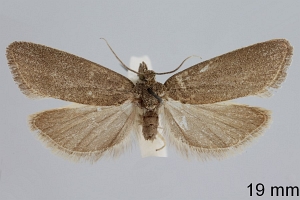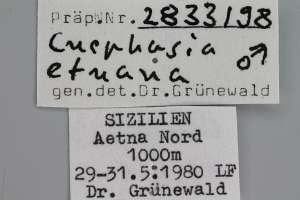Inhalt
4. Weitere Informationen
4.1. Etymologie (Namenserklärung)
Razowski & Trematerra (1999: 14): “Derivatio nominis. The name of the new Cnephasia derives from the Mount Etna, Sicily Italy.”
4.2. Faunistik
Locus typicus: Vulkan Etna auf Sizilien.
4.3. Typenmaterial
Razowski & Trematerra (1999: 12): “Holotype, male and allotype, female both labelled as follows: “Mte Etna vers Sud., Castagneti di Pedara, 900-1100 m., 26.V.49, H[ar]t[i]g leg.” (collection: Museo di Zoologia dell'Università di Roma “La Sapienza”, Rome).
Paratypes: 7 males and 1 female, same data of holotype, but 14.V.49; 1 male and 5 females, same data of holotype, but 26.V.49; 1 female, M.te Etna vers. Sud, Regala 800 m. (Pedara), 23.V.49, H[ar]t[i]g leg. (collections: Museo di Zoologia dell'Università di Roma “La Sapienza”, Rome; Trematerra, Campobasso.”
4.4. Literatur
- Erstbeschreibung: Razowski, J. & P. Trematerra (1999): Description of a new species of Italian Cnephasia Curtis, 1826, from Mount Etna, with notes on the cnephasiine ovipositor (Lepidoptera Tortricidae). — Bolletino di Zoologia agraria e di Bachicoltura, serie II 31 (1): 11-15.








